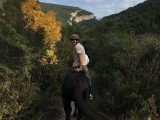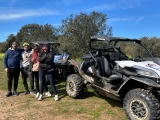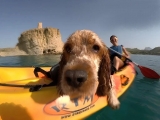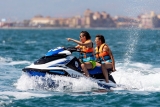Who wouldn't like to fly at some point? It's the typical question we ask ourselves when we see someone piloting any aircraft. Would you like to learn how to pilot a glider?
Gliding is an air sport that allows you to enjoy a completely relaxing yet thrilling experience. What options does it offer you? There are various types of motorless flight for you to choose your favourite, but you'll need to complete a course at a specialised centre if you want to learn with complete safety.
If a few days ago we looked at motorless flight safety regulations, now we'll examine the different modalities you can find in this sport.

Types of Motorless Flight
- Cross-country Flight. To undertake this activity you'll need sufficient capability to control flight in unfamiliar fields. For training, it's best to practice landing while previously defining the imaginary boundaries of an emergency field. It's very important that you learn to fly while controlling altitude to the point of not needing to consider altimeter readings; for example, it's advisable to learn to visually estimate the height of buildings, poles or animals, among other things. During your course, for practice you can try covering the altimeter to train yourself and develop the ability to make realistic estimates about flight location. Tip: remember that the altimeter is only helpful if both the altitude and adjustment are known, and if we're operating within reasonable limits.
- Gliding Flight. To reach this level, you'll need to have completed previous lessons and have sufficient capability to locate updrafts and gain altitude in free flight. For this type of flight you need to know which cloud types will allow climbs and distinguish between dissipating and developing cumulus clouds. You must also recognise characteristic thermal shapes as they lean windward. Develop your sense of orientation, as when circling you'll need to know your position relative to the ground. With time you'll discern upward and downward accelerations as well as different air current changes. To find thermals, the best approach is to fly straight and level, noting that if flying upwind relative to the ground, you can continue at lower altitude before rejoining traffic. Important: never seek updrafts when flying at low altitude downwind.

- Ridge Flying. Before attempting this type of flight independently, you must first do so with a professional pilot, as the flying is somewhat more complex. It's crucial to study potential emergency landing locations beforehand. If other pilots regularly fly in the area, you must know the local air traffic rules. Some circulation rules include: making turns away from the ridge, when overtaking another pilot do so between them and the slope to avoid collisions, if thermals exist avoid turning near the ridge to not interfere with other pilots using dynamic lift, among others.
- Instrument or Cloud Flying. This isn't required for a glider pilot licence, but if undertaking cross-country flights it's advisable to have the skill to maintain straight and level flight or execute normal short-duration turns. Without an artificial horizon, you'll need to use the turn and bank indicator, airspeed indicator and variometer to acquire the aforementioned skills.

Remember that for any type of motorless flight it's important to be properly qualified, having completed relevant courses and practised with a professional instructor. Above all, the best approach is to practise and not assume that minimal sessions will enable you to pilot an aircraft in all weather conditions - overconfidence can lead to serious problems, not just for yourself but other pilots too.












